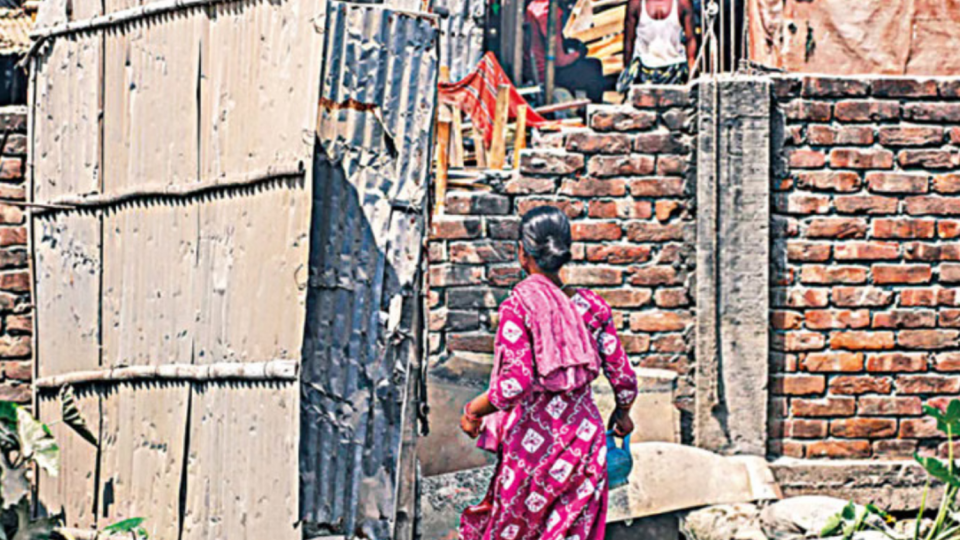September 23, 2025
DHAKA – Behind the walls and the daily chaos lies a harsher reality for the marginalised communities living in Dhaka’s bursting slums. Here, life is reduced to cramped quarters, scarce access to clean water, shared and often unsafe sanitation facilities, and virtually no privacy. These settlements are breeding grounds of vulnerability, especially for women and girls who are systemically ignored.
Mina, an informal domestic worker, begins her day long before her husband wakes. After preparing his meal and serving him, only then—at 7:30 a.m.—does her formal workday begin, though her labour never truly ends. One night, returning home from work at around 11 p.m., she was met with lewd remarks. When she told her husband about the incident, instead of sympathy, he beat her for daring to work late.
Never-ending gender-based violence
The indifference of men in these low-income neighbourhoods is striking. Women are seen bearing immense burdens, working tirelessly both at home and outside, often with little recognition, no shared responsibility, and grave concerns about safety for themselves and their children.
Dr Sanzida Akhter, Professor at the Department of Women and Gender Studies, University of Dhaka, shares: “Poverty, gender-based violence, and lack of opportunities reinforce one another, particularly for adolescent girls and women working in garments or as domestic help. Returning home late only increases their exposure to risk. But they have no choice. They must work.”
Findings from the SAFE programme, implemented between March 2012 and October 2013, revealed that by 2015, 54% of ever-married women had experienced physical and/or sexual IPV (intimate partner violence) by their husbands. The situation was particularly dire in urban slums, where 35% of women reported experiencing IPV in 2014 alone.
Recent figures are even more alarming, leaving us wondering whether any change has happened in the last decade. The 2024 Violence Against Women Survey by the Bangladesh Bureau of Statistics (BBS), based on interviews with 27,476 women, found that IPV disproportionately affects women with no formal education—80% had experienced it in their lifetime, and 42% in the past year.
Dr Anwara Begum, Research Director at the Bangladesh Institute of Development Studies (BIDS), underscores the role of entrenched patriarchy, poor law enforcement, and poverty-driven vulnerabilities that limit women’s ability to advocate for their own safety.
“Women in Dhaka’s low-income areas face significant risks due to a confluence of social, economic, and infrastructural factors. Victim-blaming attitudes and a culture of silence often dissuade women from reporting incidents, perpetuating cycles of violence,” she says. Verbal abuse, sexual harassment, non-consensual photography, groping, and rape are disturbingly common, whether in public spaces, at work, or even within their own homes.

Lingering impact of poor sanitation
In a dimly lit alleyway in Dhaka North, 14-year-old Sultana was going to the toilet when a man suddenly embraced her from behind. A witness misconstrued the situation, and within days, rumours spread. Her family, already marginalised, was evicted, cast out by the weight of shame and societal stigma. This is not an isolated incident.
“In slums, fetching water or bathing often happens in open, insecure areas. Shared toilets are dominated by men, poorly lit, and lack locks,” says Bulbul Bala, Programme Lead at WaterAid Bangladesh.
Morning routines often see women and children queuing behind male elders for limited facilities, delaying school or work. Menstrual hygiene is another challenge jeopardising women’s health and dignity.
According to WaterAid Bangladesh’s Gender Assessment under the WASH for Urban Poor Project – Phase II, 9% of women reported experiencing violence during water collection. In Dhaka North City Corporation, over 70% of women reported encountering gender-based violence while accessing sanitation facilities.
This increases the vulnerability of adolescent girls, children, and women, especially those left home alone during the day.
When children become victims
That vulnerability was painfully clear for a 10-year-old madrasa student living in a small attic in Baridhara. With her father deceased and her mother away at work, she was left alone when a 40-year-old family acquaintance entered the house and raped her.
In many of these homes, children are left with a neighbour or fend for themselves, as mothers endure long, exhausting shifts. The threat of abuse is constant. A piece of chocolate, a false promise—these become tools of manipulation. And the scars, both physical and emotional, last a lifetime.
“The environment itself enables perpetrators,” explains Dr Sanzida. “Girls are exposed, both physically and emotionally. And with mothers working long hours in the informal sector, often without any childcare support, the vulnerability increases tenfold,” she further adds.
NGOs and grassroots organisations are working on installing streetlights, community toilets, organising self-defence workshops, and running awareness programmes, but their reach is limited. Moreover, infrastructure is only part of the solution.
A streetlight can stop working. A toilet can be locked. What women and children need is not quick fixes but lasting change—one that dismantles the invisible power structures keeping them vulnerable. Unless government, NGOs, law enforcement agencies, and community leaders come together, these stories will keep repeating, and countless women and girls will continue to slip through the cracks.
Saudia Afrin is a development practitioner, currently working as a communications officer at BELA (Bangladesh Environmental Lawyers Association).


